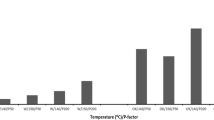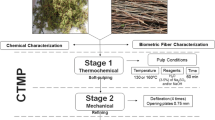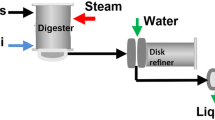Abstract
Considering the environmental impact and fluctuating price of fossil fuels, interest is growing in the alternatives sources. As a result, the lignocellulosic materials are becoming more popular for the production of chemicals and energy, in addition to pulp in the frame of biorefinery concept to provide a sustainable, environmentally friendly, and reliable resource. In order to assess agricultural wastes for the production of dissolving pulp in a biorefinery concept, rice straw, wheat straw, mustard branch and stem, and lentil stalks were characterized. These agricultural wastes are characterized by relatively moderate amounts of lignin (20–23 %), reasonably low amounts of α-cellulose (35–40 %), and relatively high amounts of ash (4–15 %) contents. For producing dissolving pulp, the prehydrolysis of rice straw, wheat straw, mustard stalks, and lentil stalks was carried out prior to kraft pulping. The prehydrolysis resulted in significant dissolution of biomass (32–39 %) from rice straw, wheat straw, mustard branch, and lentil stalks, which includes lignin (4–7 %), acetic acid (4–7 %), and sugars (11–18 %). The hemicelluloses present in the prehydrolysis liquor (PHL) can be used to produce ethanol by fermentation or for other products such as furfural. Generated acetic acid from the hemicelluloses-bound acetyl groups inhabits fermentation in ethanol production. Therefore, separation of acetic acid from PHL improves fermentation of sugars in PHL and also increases the revenue of pulp industry. Prehydrolyzed biomass was cooked through kraft process and yielded 30–38 % of pulp based on the original raw material with kappa number in the range of 11–21. The produced pulp was bleached by D0EpD1EpD2 bleaching stages. The bleached pulp showed very high brightness (85–90 %) and high α-cellulose content (95–98 %).
Similar content being viewed by others

References
Amidon TE, Liu S (2009) Water-based woody biorefinery. Biotechnol Adv 27(5):542–550
van Heiningen A (2006) Converting a kraft pulp mill into an integrated forest biorefinery. Pulp Paper Canada 107:38–43
Jahan MS, Saeed A, Ni Y, He Z (2009) Pre-extraction and its impact on the alkaline pulping of bagasse. J Biobased Mat Bioenergy 3(4):380–385
Jahan MS, Shamsuzzaman M, Rahman MM, Iqbal Moeiz SM, Ni Y (2012) Effect of pre-extraction on soda-anthraquinone (AQ) pulping of rice straw. Ind Crops Prods 37:164–169
Jahan MS, Rahman MM (2012) Effect of pre-hydrolysis on the soda-anthraquinone pulping of corn stalks and Saccharum spontaneum (kash). Carbohydr Polym 88:583–588
Saeed A, Jahan MS, Li H, Liu Z, Ni Y, van Heiningen A (2012) Mass balances of components dissolved in the pre-hydrolysis liquor of kraft-based dissolving pulp production process from Canadian hardwoods. Biomass Bioenergy 39:14–19
Liu X, Fatehi P, Ni Y (2011) Adsorption of lignocelluloses dissolved in prehydrolysis liquor of kraft-based dissolving pulp process on oxidized activated carbons. Ind Eng Chem Res 50:11706–11711
Ahsan L, Jahan MS, Ni Y (2013) Recovery of acetic acid from pre-hydrolysis liquor of the Kraft based dissolving pulp production process by reactive extraction with tri-octyl amine(TOA) and octanol. Accepted in PAPTAC Conference 2013, 4–7, February, Montreal, Canada
Xing R, Qi W, Huber GW (2011) Production of furfural and carboxylic acids from waste aqueous hemicellulose solutions from the pulp and paper and cellulosic ethanol industries. Energy Environ Sci 4:2193–2205
Weingarten R, Cho J, Conner WC, Huber GW (2010) Kinetics of furfural production by dehydration of xylose in a biphasic reactor with microwave heating. Green Chem 12:1423–1429
Takahashi S, Tanifuji K, Shiell KM, Sarwar Jahan, Ohi H, Ni Y (2012) Removal of acetic acid from spent sulfite liquor using anion exchange resin for effective xylose fermentation with pichia stipitis. The 4th International Conference on Pulping, Papermaking and Biotechnology November 7–9, 2012 Nanjing, China
Biermann CJ (1993) Essentials of pulping and papermaking. Academic, New York, pp 72–100
Hinck JF, Casebier RL, Hamilton JK (1985) In: Ingruder OV, Kocurek JJ, Wong W (eds) Pulp and paper manufacture, vol. 4. Tappi, Atlanta, pp 213–243
Krässig HA (1993) In: Huglin MB (ed) Structure, accessibility and reactivity. Polymer monographs, vol. 11. Gordon and Breach, Amsterdam
Sjöström E (1981) Wood chemistry: fundamentals and applications. Academic, New York, pp 169–189
FAO. (2005) Forest resource assessment.
Abou-State MA, El-Megeld FFA, Nesseem RI (1983) Dissolving pulps from zea maize by alkaline sulfide and sulfite pulping. Ind Eng Chem Prod Res Dev 22:506–508
Villavicencio EJ (1980) Method for preparing bagasse dissolving pulps and producing rayon having a degree of polymerization of at least 800 therefrom US Patent 4,199,399.
Jahan MS, Al-Maruf A, Quaiyyum MA (2007) Comparative studies of pulping of jute fiber, jute cutting and jute caddis. Bangladesh J Sci Ind Res 42(4):425–434
Jahan MS, Rawsan S, Chowdhury DAN, Al-Maruf A (2008) Alternative pulping process for producing dissolving pulp from jute. BioRes 3(4):1359–1370
Jahan MS (2009) Studies on the effect of prehydrolysis and amine in cooking liquor on producing dissolving pulp from jute (Corchorus capsularis). Wood Sci Technol 43:213–224
Browining BL (1967) Methods in wood chemistry. Wiley, New York
Ni Y, Kang GJ, van Heiningen ARP (1996) Are hydroxyl radicals responsible for degradation of carbohydrates during ozone bleaching of chemical pulp. J Pulp Paper Sci 22(2):53–57
Jahan MS, Haider MM, Rahman MM, Mondal GK, Biswas D (2011) Evaluation of rubber wood (Hevea brasiliensis) as a pulping and papermaking raw materials. Nordic Pulp and Paper Research J 26(3):258–262
Jahan MS, Chowdhury DAN, Ni Y (2010) Effect of different locations on the morphological, chemical, pulping and papermaking properties of Trema orientalis (Nalita). Bioresour Technol 101:1892–1898
Jahan MS, Mun SP (2004) Effect of tree age on the soda-anthraquinone pulping of Nalita wood (Trema orientalis). Korean J Ind Eng Chem 10(5):766–771
Gunter BG, Jahan MS, Rahman AAFM (2010) Papermaking from jute: a win–win solution for Bangladesh. J Bangladesh Studies 12(2):46–56
Jahan MS, Sabina R, Tasmin B, Chowdhury DAN, Noori A, Al-Maruf A (2009) Effect of harvesting age on the chemical and morphological properties of dhaincha (Sesbania aculeata) and its pulpability and bleachability. BioRes 4(2):471–481
Leschinnsky M, Sixta H, Patt R (2009) Detailed mass balances of the autohydrolysis of Eucalyptus globulus at 170 °C. BioRes 4(2):687–703
Tunc MS, van Heiningen ARP (2008) Hydrothermal dissolution of mixed southern hardwoods. Holzforschung 62(5):539–545
Larsson S, Palmqvist E, Hahn-Hägerdal B, Tengborg C, Stenberg K, Zacchi G, Lei Y, Liu S, Li J, Sun R (2010) Effect of hot-water extraction on alkaline pulping of bagasse. Biotechnol Adv 28:609–612
Palmqvist E, Hahn-Hägerdal B (2000) Fermentation of lignocellulosic hydrolysates. II: inhibitors and mechanisms of inhibition. Bioresour Technol 74:25–33
Jahan MS, Rahman MM (2012) A biorefinery initiative in producing dissolving pulp from dhaincha (Sesbania aculeata)—a short-rotation crop. Cellulose Chem Technol 46(5–6):375–380
Geankoplis CJ (2003) Transport processes and separation process principles, 4th edn. Prentice Hall, Upper Saddle River
Grzenia DL, Schell DJ, Wickramsinghe RS (2010) Detoxification of biomass hydrolysates by reactive membrane extraction. J Membrane Science 348(1–2):6–12
Satheesh MNK, Mohanty AK, Erickson L, Misra M (2009) Lignin and its applications with polymers. J Biobased Materials Bioenergy 3(1):1–24
Wang H, Ni Y, Jahan MS, Liu Z, Schafer T (2011) Stability of cross-linked acetic acid lignin-containing polyurethane. J Thermal Colorometry 103(1):293–302
Perez JA, Gonzalez A, Oliva JM, Ballesteros I, Manzanares P (2007) Effect of process variables on liquid hot water pretreatment of wheat straw for bioconversion to fuel-ethanol in a batch reactor. J Chem Technol Biotechnol 82:929–938
Sreenath HK, Koegel RG, Moldes AB, Jeffries TW, Straub RJ (1999) Enzymic saccharification of alfalfa fiber after liquid hot water pretreatment. Process Biochem 35:33–41
Dietrichs HH (1964) Behaviour of carbohydrates during heartwood formation. Holzforschung 18(1–2):14–24
Ban W, van Heiningen A (2011) Adsorption of hemicellulose extracts from hardwood onto cellulosic fibers. I. Effects of adsorption and optimization factors. Cellulose Chem Technol 45(1-2):57–65
Ban W, Chen X, Andrews G, van Heiningen A (2011) Influence of hemicelluloses pre-extraction and re-adsorption on pulp physical strength. II: Beatability and strength study. Cellulose Chem Technol 45(9-10):633–641
Jahan MS, Ahsan L, Noori A, Quaiyyum MA (2008) Process for the production of dissolving pulp from trema orientalis (Nalita) by prehydrolysis kraft and soda-ethylenediamine (EDA) process. BioRes 3(3):816–828
Kordsachia O, Roβkopf S, Patt R (2004) Production of spruce dissolving pulp with the prehydrolysis–alkaline–sulfite precess (PH-ASA). Lenzinger Berichte 83:24–34
Esa S, Jesse K, Irina R, Kaj B (2012) Characteristics of prehydrolysis-kraft pulp fibers from Scots pine. Holzforschung 66:801–808
Carrasco F, Roy C (1992) Kinetic study of dilute-acid prehydrolysis of xylan-containing biomass. Wood Sci Technol 26:189–208
Rydholm S (1967) Multistage cooking processes. In: Rydholm S (ed) Pulping processes. Int. Pub, New York, pp 649–672
Behin J, Mikaniki F, Fadaei Z (2008) Dissolving pulp (alpha-cellulose) from corn stalk by kraft process. Iranian J Chem Eng 5(3):14–28
Author information
Authors and Affiliations
Corresponding author
Rights and permissions
About this article
Cite this article
Jahan, M.S., Sultana, N., Rahman, M. et al. An integrated biorefinery initiative in producing dissolving pulp from agricultural wastes. Biomass Conv. Bioref. 3, 179–185 (2013). https://doi.org/10.1007/s13399-012-0067-x
Received:
Revised:
Accepted:
Published:
Issue Date:
DOI: https://doi.org/10.1007/s13399-012-0067-x



